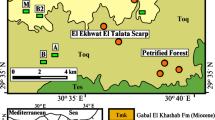Abstract
In forensic contexts, time since death assessment in human skeletal remains is crucial for identification, and both accuracy and reliability are required. In this paper, we present the possibilities and constraints of the use of 210Pb in dating skeletonized human bones in Morocco. The method was tested on recent as well as archaeological bones of known dates of death. A calibration curve was obtained from the available data in the scientific literature. The 210Pb initial activity was introduced as an increasing lineal function with time. The 210Pb dating approach gives promising results only for recent bones. On the contrary, for archaeological bones, the technique has erroneously led to post-mortem intervals in the range of recent bones which constitute a serious limitation of the method. On the other hand, uranium isotopes content in bones is suggested in this work as a possible indicator in placing a studied bone within either a forensic or archaeological context.



Similar content being viewed by others
References
Kandlbinder R, Geibler V, Shupfner R, Wolfbeis O, Zinka B (2009) Analysing 228Th, 232Th, 228Ra in human bone tissues for the purpose of determining the post mortal interval. J Radioanal Nucl Chem 280(1):113–119
Prieto-Castello MJ, Hernández del Rincón JP, Pérez-Sirvent C, Alvarez-Jiménez P, Pérez-Cárceles MD, Osuna E, Luna A (2007) Application of biochemical and X-ray diffraction analyses to establish the postmortem interval. Forensic Sci Int 172:112–118
Swift B, Lauder I, Black S, Norris J (2001) An estimation of the post-mortem interval in human skeletal remains: a radionuclide and trace element approach. Forensic Sci Int 117:73–87
Swift B (1998) Dating human skeletal remains: investigating the viability of measuring the equilibrium between 210Po and 210Pb as a means of estimating the post-mortem interval. Forensic Sci Int 98:119–126
Laissaoui A, Benmansour M, Ziad N, Majah MI, Abril JM, Mulsow S (2008) Anthropogenic radionuclides in the water column and a sediment core from the Alboran Sea: application to radiometric dating and reconstruction of historical water column radionuclide concentration. J Paleolimn 40(3):823–833
Rubin KH, Macdougall JD, Perfit MR (1994) 210Po–210Pb dating of recent volcanic eruptions on the sea floor. Nature 28:841–844
Al-Masri MS, Mukallati H, Al-Hamwi A, Khalili H, Hassan M, Assaf H, Amin Y, Nashawati A (2004) Natural radionuclides in Syrian diet and their daily intake. J Radioanal Nucl Chem 260(2):405–412
Rabinowitz MB (1991) Toxicokinetics of bone lead. Environ Health Persp 91:33–37
Wittmers LE, Wallgren J, Alich A, Aufderheide AC, Rapp G (1988) Lead in bone IV. Distribution of lead in the human skeleton. Arch of Environ Health 48:6381–6391
Edward J (1990) Ion exchange behaviour of fresh human bone. J Radioanal Nucl Chem, letters 144(4):317–322
Stahlhofen W (1964) Measurement of the natural content of 228Th 226Ra and their daughters in the human body. Assessment of radioactivity in man. International Atomic Energy Agency, Vienna, 505–519
Tandon L, Iyengar GV, Parr RM (1998) A review of radiologically important trace elements in human bones. Appl Radiat Isot 49(8):903–910
Harley NH, Fisenne IM (1990) Distribution and alpha radiation dose from naturally occurring U, Th and Ra in the human skeleton. Health Phys 58:515–518
Ibrahim SA, Simon SL (2000) Natural radionuclide contents in human whole-body ashes. J Radioanal Nucl Chem 243(2):483–490
Singhal RK, Sharma PK, Bassan MKT, Basu H, Reddy AVR (2011) Comparative determination of uranium in rock phosphates and columbite by ICP-OES, alpha and gamma spectrometry. J Radioanal Nucl Chem 288:149–156
Matthews KM, Kim CK, Martin P (2007) Determination of 210Po in environmental materials: a review of analytical methodology. Appl Radiat Isot 65:267–279
Johnston PN, Hult M, Gasparro J, Martínez-Canet MJ, Vasselli R, McKenzie RJ, Solomon SB, Lambrichts I (2005) The distribution of 210Pb in human bone and its impact on methods for the retrospective estimation of 222Rn exposure from in vivo measurements. J of Environ Radioact 80:245–257
Millard AR, Hedges REM (1996) A diffusion–absorption model of uranium uptake by archaeological bone. Geochim et Cosmochim Acta 60(12):2139–2152
Neis P, Hille R, Paschke M, Pilwat G, Schnabel A, Niess C, Bratzke H (1999) Strontium-90 for determination of time since death. Forensic Sci Int 99:47–51
MacLaughlin-Black SM, Ruth JMH, Wilson K, Myers M, West IE (1992) Strontium-90 as an indicator of time since death: a pilot study. Forensic Sci Int 57:51–56
Author information
Authors and Affiliations
Corresponding author
Rights and permissions
About this article
Cite this article
Ziad, N., Zarki, R., Benmansour, M. et al. Determination of 210Pb in human skeletal remains from Morocco: implications for time since death assessment. J Radioanal Nucl Chem 292, 315–319 (2012). https://doi.org/10.1007/s10967-011-1416-0
Received:
Published:
Issue Date:
DOI: https://doi.org/10.1007/s10967-011-1416-0




